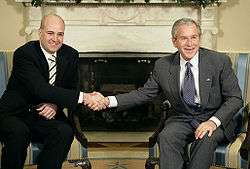Sweden–United States relations
 |
|
Sweden |
United States |
|---|---|


Swedish–American relations reach back to the days of the American Revolutionary War. The Kingdom of Sweden was the first country not formally engaged in the conflict (though thousands of Swedish volunteers partook on the side of the patriots) to recognize the United States of America following the Treaty of Paris. The Treaty of Amity and Commerce was signed subsequently in 1784 between Benjamin Franklin and Swedish representative Gustaf Philip Creutz.
According to the 2012 U.S. Global Leadership Report, 36% of Swedes approve of U.S. leadership, with 30% disapproving and 34% uncertain.[1]
History of relations
Like many European powers, Sweden participated in the colonization of America that started in the 17th century. The first Swedish colony along the banks of the Delaware River was established in 1638 (see New Sweden).
Sweden was the first country not engaged in the American Revolutionary War to recognize the young American republic. The Swedish Count Axel von Fersen was a distinguished soldier during the war, serving as an interpreter between General Rochambeau and General Washington. In 1783 the United States' Ambassador to Paris, Benjamin Franklin, and the Swedish Ambassador, Count Gustaf Philip Creutz, signed a Treaty of Amity and Commerce.[2]
During the period between 1820–1930 approximately 1.3 million Swedes, a third of the country's population, emigrated to North America and most of them to the United States. Like the Irish diaspora it was sparked by poverty in Sweden, which was exacerbated during bad years. Only Britain (especially Ireland) and Norway had a higher emigration rate. Most of the Swedish emigrants settled in the central and Western United States. By 1910, Chicago had a greater population of Swedes than Gothenburg. Minnesota was also a place where many Swedish emigrants settled. The majority of Swedish-Americans fought in the American Civil War on the Union side. (See also John Ericsson#USS Monitor)
The first Swedish head of government who met with a US President was Prime Minister Tage Erlander, who visited Harry S. Truman at the White House in 1952.
The period between 1968 and 1976 also marked a cold period in the political relations between Sweden and the U.S., mainly due to the Swedish government's vocal opposition to the Vietnam War. In February 1968, the US recalled its Ambassador from Sweden after the Swedish Minister of Education and future prime minister Olof Palme, a Social Democrat, had participated in a protest in Stockholm against the war together with the North Vietnamese Ambassador to the Soviet Union Nguyen Tho Chan.[3] The post of US Ambassador to Sweden remained vacant until February 1970. In December 1972, Olof Palme (then Prime Minister) made a speech on Swedish national radio where he compared the ongoing US bombings of Hanoi to some of the worst atrocities committed by the Nazis. The US government called the comparison a "gross insult" and once again decided to freeze its diplomatic relations with Sweden (this time the freeze lasted for over a year).[3]
Relations improved when Thorbjörn Fälldin became Swedish prime minister in 1976, and following Olof Palme's death in 1986 and the succession of Ingvar Carlsson as new Prime Minister, Swedish-American relations improved. Ingvar Carlsson met with President Ronald Reagan in 1987, the first time that a Swedish Prime Minister was invited to the White House since 1961, when Erlander paid a visit to Kennedy.
Carlsson's successor as Prime Minister, Carl Bildt, visited both President George H. W. Bush in 1992 and President Bill Clinton in 1994.
Immediately after the September 11, 2001 attacks, the Swedish government expressed its sympathies with the U.S. and supported the U.S.-led invasion of Afghanistan.[4][5] However, like many other European governments, Sweden opposed the 2003 invasion of Iraq, reasoning that the invasion was a breach of international law.[6] However, Prime Minister Göran Persson was relatively mild in his criticism of the U.S. compared to Olof Palme's strong criticism during the Vietnam War.
In the Statement of Government Policy presented to the Riksdag on October 6, 2006, the new centre-right Prime Minister Fredrik Reinfeldt declared that the new government will work for a "strengthening of the transatlantic link".[7] Reinfeldt's party, the Moderate Party, is more pro-American than the social democrats and supported the 2003 invasion of Iraq and Swedish membership of NATO. Reinfeldt visited President Bush at the White House on May 15, 2007.
Economic relations
The United States and Sweden have strong economic relations. The United States is currently the third-largest Swedish export trade partner,[8] and U.S. companies are the most represented foreign companies in Sweden.
Military relations
Although Sweden has a longstanding policy of political neutrality in international affairs, Sweden is a participant in the Euro-Atlantic Partnership Council. Sweden currently participates with around 500 troops in the International Security Assistance Force (ISAF), under the command of NATO, in Afghanistan. Two of the four parties in the ruling coalition supports NATO membership. During the Libyan Civil War of 2011, the Swedish Air Force worked closely with NATO and USA.
During the Cold War, the Swedish government secretly made preparations to receive military aid from the United States in case of Soviet aggression.[9]
Cultural links
Reflecting the fact that Sweden has a higher proportion of English speakers than most other countries which were never part of the British Empire, Swedish producers and songwriters have played a significant role in the sound of American pop music since the 1990s. One in particular, Max Martin, has written and produced more Billboard Hot 100 number one hits than any American songwriter or producer.[10]
List of visits
See also
- Nordstjernan (newspaper)
- Swedish Americans
- List of Swedish Americans
- Languages of the United States#Swedish
- Swedish response to Hurricane Katrina
- United States Ambassador to Sweden
- List of Swedish Ambassadors to the United States
References
- ↑ U.S. Global Leadership Project Report - 2012 Gallup
- ↑ American Memory from the Library of Congress
- 1 2 Andersson, Stellan. "Olof Palme och Vietnamfrågan 1965–1983" (in Swedish). olofpalme.org. Retrieved February 27, 2008.
- ↑ Utrikesminister Anna Lindh med anledning av terrorattacken i USA | Press & info | Utrikesdepartementet | Departement | Regeringskansliet
- ↑ Kammarens protokoll – Riksdagen
- ↑ http://statsradsberedningen.regeringen.se/pub/road/Classic/article/13/jsp/Render.jsp?m=print&d=1122&nocache=true&a=7138
- ↑ Swedish Riksdag
- ↑ Exports to large trade partners, Statistics Sweden, accessed October 14, 2007.
- ↑ SOU 1994:11 Om kriget kommit... Förberedelser för mottagande av militärt bistånd 1949–1969
- ↑ http://www.billboard.com/articles/columns/chart-beat/6656874/max-martin-new-no-1-billboard-hot-100-the-weeknd Billboard
- ↑ Memorandum of Conversation Gerald R. Ford Library, Accessed on May 17, 2010
External links
![]() Media related to Relations of Sweden and the United States at Wikimedia Commons
Media related to Relations of Sweden and the United States at Wikimedia Commons
| ||||||||||||||||||||||||||||
| ||||||||||||||||||||||||||||||||||||||||||||||||||||||||||||||||||||||||||||||||||||||||||||||||||||||||||||||||||||||||||||||||||

.svg.png)